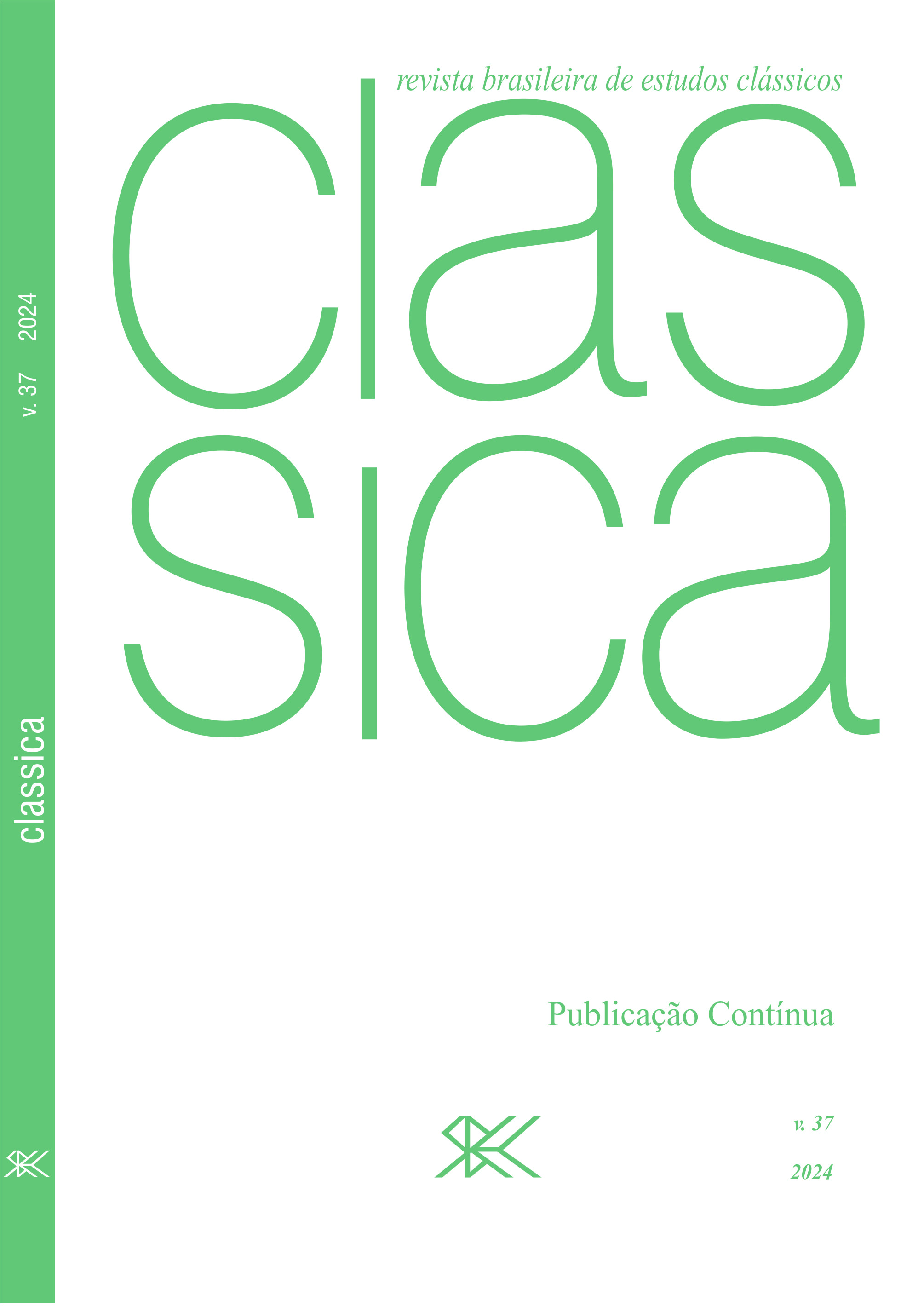Uma nova lista de ferimentos, mortes e atos de agressão na Ilíada
DOI:
https://doi.org/10.24277/classica.v37.2024.1083Palavras-chave:
Homero; Ilíada; ferimentos; mortes; guerra.Resumo
Este artigo apresenta uma lista nova, digital e interativa de ferimentos, mortes e outros atos de agressão na Ilíada. Após uma introdução, ele discute o estado da arte em abordagens quantitativas do assunto. A seção seguinte apresenta a metodologia de compilação dos dados, estabelecendo brevemente os critérios para a distribuição das instâncias em cada categoria. Na discussão, comparo os resultados com projetos semelhantes anteriores e menciono alguns exemplos da potencialidade da nova lista – a ser publicada on-line, não incluída no artigo –, mostrando as vantagens do formato digital.
Downloads
Referências
ABRITTA, Alejandro et al. Ilíada: Canto 16. Commentary and notes by A. Abritta. Buenos Aires: iliada.com.ar, 2021.
ABRITTA, Alejandro. Ilíada: Canto 5. Texto bilingüe comentado. Buenos Aires: iliada.com.ar, 2022.
ALEXANDER, Caroline. The Iliad. New York: Harper Collins, 2015.
CORAY, Marina; KRIETER-SPIRO, Martha; VISSER, Eedzerd. Homer’s Iliad. The Basel Commentary. Book IV. Ed. Anton Bierl and Joachim Latacz. English edition by S. Douglas Olson. Trans. Benjamin W. Millis and Sara Strack. Berlin: De Gruyter, 2020.
FENIK, Bernard. Typical Battle Scenes in the Iliad. Studies in the Narrative Techniques of Homeric Battle Description. Wiesbaden: Franz Steiner, 1968.
FRIEDRICH, Wolf-Hartmut. Wounding and Death in the Iliad: Homeric Techniques of Description. Trans. Gabriele Wright and Peter Jones. Appendix by K. B. Saunders. London: Duckworth, 2003.
FRÖLICH, H. Die Militärmedicin Homer’s. Stuttgart: Verlag von Ferdinand Enke, 1879.
GARLAND, Robert. The Causation of Death in the Iliad: A Theological and Biological Investigation. BICS, v. 28, p. 43-60, 1981.
JENKINSON, L. E. Deaths in The Iliad: A Classics infographic.July 20, 2014. Available at: https://greekmythcomix.com/comic/deaths-in-the-iliad-a-classics-infographic. Access: 14 Mar. 2024.
JOHNSTON, Ian. Deaths in the Iliad.August 1, 2013. Available at: http://johnstoniatexts.x10host.com/homer/iliaddeaths.htm. Access: 14 Mar. 2024.
KAYHANIAN, Saeed, and MACHADO, Robert J. Head Injuries in Homer’s Iliad.World Neurosurgery, v. 143, p. 33-7, 2020.
LATACZ, Joachim. Kampfparänese, Kampfdarstellung und Kampfwirklichkeit in der Ilias, beiKallinos und Tyrtaios. Munich: C. H. Beck, 1977.
MORRISON, James V. Homeric Darkness: Patterns and Manipulation of Death Scenes in the Iliad. Hermes, v. 127, p. 129-44, 1999.
MYLONAS, Anastassios I. et al. Cranio-maxillofacial injuries in Homer’s Iliad. Journal of Cranio-Maxillofacial Surgery, v. 36, p. 1-7, 2008.
NOMIKOS, Nikitas. Injuries in the Greek epics of Homer. Chinese Journal of Traumatology, v. 30, p. 1-4, 2018.
RALLI, Ioanna et al. Facial trauma in the Trojan War. Oral Maxillofacial Surgery, v. 19, p. 191-4, 2014.
SAPOUNAKIS, C. et al. Injuries to the head and neck in Homer’s Iliad. British Journal of Oral and Maxillofacial Surgery, v. 45, p. 112-5, 2007.
SAUNDERS, K. B. A Note on the Strange Death of Mydon in Iliad 5. SO, v. 75, p. 24-33, 2000.
SAUNDERS, K. B. Frölich’s Table of Homeric Wounds. CQ, v. 54, p. 1-17, 2004.
SCHIRONI, Francesca. The Best of the Grammarians. Ann Arbor: University of Michigan Press, 2018.
SWINNEY, Christian. Helmet Use and Head Injury in Homer’s Iliad.World Neurosurgery, v. 90, p. 14-9, 2016.
VAN WEES, Hans. The Homeric Way of War: The Iliad and the Hoplite Phalanx. G&R, v. 41, n. 1, p. 1-18, and n. 2, p. 131-55, 1994.
Downloads
Publicado
Edição
Seção
Licença
Copyright (c) 2024 Alejandro Abritta

Este trabalho está licenciado sob uma licença Creative Commons Attribution 4.0 International License.
Autores que publicam nesta revista concordam com os seguintes termos:
a. Autores mantém os direitos autorais e concedem à revista o direito de primeira publicação, com o trabalho simultaneamente licenciado sob a Creative Commons Atribuição 4.0 Internacional (CC BY 4.0) que permite o compartilhamento do trabalho com reconhecimento da autoria e publicação inicial nesta revista.
b. Autores têm autorização para assumir contratos adicionais separadamente, para distribuição não-exclusiva da versão do trabalho publicada nesta revista (ex.: publicar em repositório institucional ou como capítulo de livro), com reconhecimento de autoria e publicação inicial nesta revista.
c. Autores têm permissão e são estimulados a publicar e distribuir seu trabalho online após o processo editorial (ex.: em repositórios institucionais ou na sua página pessoal), já que isso pode gerar alterações produtivas, bem como aumentar o impacto e a citação do trabalho publicado (Veja O Efeito do Acesso Livre).
d. Autores autorizam a cessão, após a publicação, de seu conteúdo para reprodução em indexadores de conteúdo, bibliotecas virtuais, bases de dados de acesso público e similares.











